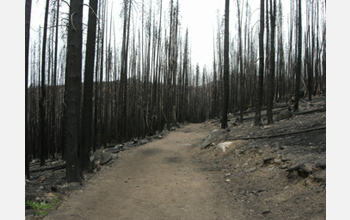|

All Images

Discovery
Economist Hedges Bets on Wildfires in California

Back to article | Note about images
 |
This picture was taken in 2007, one year after the 2006 Tripod Complex Fire in northern Washington state. The wildfires were initiated by two lightning strikes and spread over 175,000 acres of mixed conifer forest in the Okanogan National Forest. The Tripod Complex was one of the largest wildfires in Washington in the past half-century, costing more than $82 million in resources to fight. The fire threatened the nearby towns of Winthrop, Conconully and Loomis, but did not encroach.
Credit: Joanne Ho, College of Forest Resources, University of Washington |
Download the high-resolution JPG version of the image. (631 KB)
|
Use your mouse to right-click (or Ctrl-click on a Mac) the link above and choose the option that will save the file or target to your computer.
|
 |
This picture overlooks parts of the Okanogan National Forest that were not consumed by the 2006 Tripod Complex wildfire. The brown-colored trees signal that the area has been attacked by the bark beetle. Dead, standing trees (brown) intermixed with live trees increase the chances of fire occurring, and reduces the chance of survival of the neighboring live, green trees. This is because standing dead trees act as dry fuels in the canopy. They allow fire not only to burn on the ground, but also induce crown fire in the canopy.
Credit: Joanne Ho, College of Forest Resources, University of Washington |
Download the high-resolution JPG version of the image. (559 KB)
|
Use your mouse to right-click (or Ctrl-click on a Mac) the link above and choose the option that will save the file or target to your computer.
|
 |
Undergraduate and graduate students scope out the landscape on a seven-day field trip across Washington state and British Columbia, Canada. The course is designed and led by Professor Thomas Hinckley, and features natural resource management topics such as: international policies and cooperation, management for recreational objectives, Native American and First Nation perspectives on resource values and management methods, residential safety and wildfire management, wildlife habitat and biodiversity preservation.
Credit: Jorge Ramos, College of Forest Resources, University of Washington |
Download the high-resolution JPG version of the image. (512 KB)
|
Use your mouse to right-click (or Ctrl-click on a Mac) the link above and choose the option that will save the file or target to your computer.
|
|




